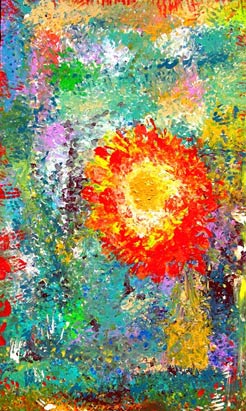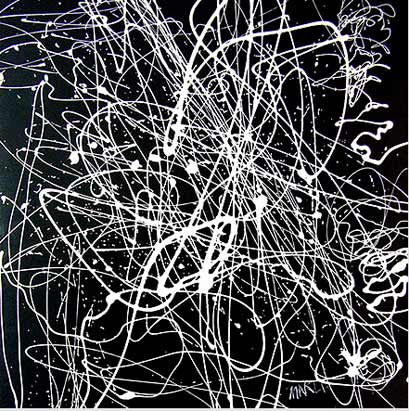Note from the author: I wrote this in college for an art criticism class. I have cited my references and hope you will always do that same. Copyright infringement is NO good. If you click on the images it will take you to the website I took them from. Also, please do not use this as your own paper. Cheating is NO good.
Scuola Grande Arciconfraternita di San Rocco Venezia
Candida Höfer’s five by seven foot photograph
Scuola Grande Arciconfraternita di San Rocco Venezia captures much more than a spectacular shot of an ornate guild hall. As part of her exhibit
Architecture of Absense
, this present day museum is empty, allowing the viewer to take in the design and sculpture of the surrounding walls as well as the emptiness of the space. With grand, rich details this hall makes a statement about the classics.
Jacopo Tintoretto
,
Vecellio Tiziano
, and
Giovanni Battista Tiepolo
, famous Venetian painters, created the magnificent frescoes that cover the walls. The marble colonnades and architectural detail date back to early Greek influences. Through the art’s religious, historical, and artistic qualities, Höfer’s photograph compels the viewer into action.
Tintoretto, the main artist, completed more than fifty religious frescoes in the hall, hoping to create a spiritual and beautiful touch to the Scuola Grande Arciconfraternita di San Rocco Venezia, or Confraternity of St. Roch. The confraternity was a lay brotherhood of worship and charity. Tintoretto, having worked on the frescoes for more than twenty years, provided the confraternity with publicity. Soon, the confraternity became a shrine to the artist and continues to be unto this day. Tourists travel to this place to admire Tintoretto’s work and remember the brotherhood who once served in the confraternity. Value is laid on history and setting of the artwork. But, perhaps of more importance, is the message trying to be displayed.
When Tintoretto created his frescoes, they were religious in nature. For centuries frescoes, mosaics, and stain glass were created to inform the average person of religious matter because most could not read or did not possess their own bible. Portrayed subjects would include the creation of Adam and Eve, biblical stories, the Madonna (or Mary, the mother of Jesus), Jesus’ life and ministry, and also saints of the church. The artwork’s intent was to educate and create a spiritual connection to the viewer.
Captured in Höfer’s photograph is the message of worship. The artwork is religious and leaves a religious, spiritual feeling. But the grandeur of the artwork receives more focus than the other religious aspects. The lines of the photographs—created by the walls, ceiling, and floor—point to the central statue of Christ on the cross. But, unlike the illiterate public of the past, modern people know about Christ and other religious stories. The artwork does not inform in today’s world; it simply relates the viewer to the time of the artists and their skill. The rich details, humanistic portrayals, and Roman and Greek influences emphasize beauty and idealism.
Greek influence is definitely prevalent in the Parthenon architectural columns on the back wall. They also serve as frames for other works of art but they are art themselves. The tall columns emphasize the power and dominance of Greek culture. It is Greek culture that all of Western civilization is based. Roman, Gothic, Renaissance, Medieval, and Baroque periods all learned from Greek philosophy, literature, and art. Ancient Greece formed the foundation for which all of the following civilizations were built upon. The three separate columns could represent the trinity of God, Jesus, and the Holy Ghost. The sculpture in the center of columns also appears to emerging from within the columns in agreement with emerging from Greece.
The modern items in the room like the lights and chairs do not distract from the richness of the room but add to its message. There are two different lighting fixtures in the room. One set of fixtures are in the Gothic tradition. They are caged luminescence shapes. They look like lanterns and aid the viewer’s eye to the room’s details. They seem to blend into the background and become part of the architecture. However, the other set of light fixtures are more modern. They are bowls of up-cast light that can be viewed as the dishes that once contained the Olympic fire, an event dating back to Ancient Greece. These lights also aid the eye upward towards the detailed and ornate ceiling design. The light on the back wall plays a huge role in highlighting the dramatic artwork behind it, giving it more motion and interest. The viewer can’t help but be drawn to it. The person depicted on the wall is reaching for the heavens. It evokes a strong religious feeling. The lights help reunite different times of Western history—Greek and Gothic—yet they work together to create a lighting aesthetic that draws one’s eyes upward to the art and heaven, emphasizing the artist’s intent.
The chairs stand out the most in this historical room. Though the red of the chairs echoes the red paint on the walls, the style of the chairs is what makes them distracting. The chairs are simple movie director chairs. They lack decoration and do not have a connection to the past. So what do these chairs say about the room or the people who visit it? Why place chairs there at all? The museum did not place plushy, comfortable, period-aged chairs in this room for a reason. The art is meant to be looked at closely and appreciatively. One is not able to look at all the works around them correctly from sitting in a chair. Different lighting and angles make a difference on how one perceives a piece of art. Often it is necessary to take in the larger picture.
Upon closer inspection of the chairs, you will find a backpack and even shadowed figures with crossed legs and books upon their knees. These ghost-like people are sitting in this room full of wondrous artwork, design, and architecture. They sit down to ponder the majesty of it all. But, director’s chairs are not the most comfortable furniture to sit on for extended periods of time. The director’s chairs push the visitors into motion by their lack of comfort. These chairs are often used by movie directors, who make decisions based on their “vision” for the movie they are creating. Like these directors, the viewers of the hall, who sit in these chairs, form their own decisions and opinions of the artwork based on their personal tastes. The chairs, the one element that has least to do with the historical context of the room, are the one item that is pushing the viewer into the room, into the past. This room is not a place to come, relax, and read a good book. This is a museum, a monument to an incredible past, a past that has shaped our present civilization. Should not the visitor come to the museum to connect with the past and to gain something from the experience?
A little off to the left of the center of the photograph there is this ghost-like entity, perhaps representing a group of people who were once in that area looking at the wall but that have moved on. But, maybe the entity represents the spirits of all who have worked so hard to create art, sculpture, architecture, and a civil society. The effects they had are still living on and touching the lives of modern day people. It could be related to the spirit of Elijah. It turns the hearts of the people to their forefathers, the founders of Western Civilization.
Scuola Grande Arciconfraternita di San Rocco Venezia by Candida Höfer is an excellent portrayal of the grand past. Though her use of lines and light she creates a vibrant feel to the room. Aspects within it—modern lights and chairs—add to the movement. The uncomfortable chairs make the visitors rise to their feet and look around and the light makes the eye travel heavenward. The people, who are vaguely viewed in the photo, are misty and ghost-like. The room, though old and historic, lives and breathes never leaving a person the same.























